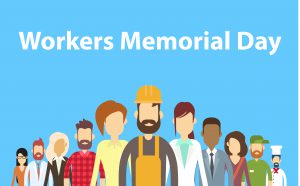Workers Memorial Day 2018: Statement from Dr. John Howard
Posted on by Every year on April 28th, we observe Workers Memorial Day, remembering those workers who have been killed or injured on the job. This is also an opportunity to reflect on how we, as a federal research institute, and our partners in industry, labor, academia and the safety and health practice community, can contribute to making our nation’s workplaces as safe and healthy as possible for all workers across America. On average, nearly 100 workers died on the job every week in 2016, according to the Bureau of Labor Statistics. While worker deaths in America are down on average—by about 63 percent since 1970—one death is too many.
Every year on April 28th, we observe Workers Memorial Day, remembering those workers who have been killed or injured on the job. This is also an opportunity to reflect on how we, as a federal research institute, and our partners in industry, labor, academia and the safety and health practice community, can contribute to making our nation’s workplaces as safe and healthy as possible for all workers across America. On average, nearly 100 workers died on the job every week in 2016, according to the Bureau of Labor Statistics. While worker deaths in America are down on average—by about 63 percent since 1970—one death is too many.
Across occupations and industries, the risks faced by workers may range from those well-known but persistent hazards, to reemerging issues, or newly seen risks as jobs and society experiences their own shifts.
While the commercial fishing industry has seen declining fatality rates, it remains one of the most dangerous jobs in America with a work-related fatality rate 23 times higher than for all workers in 2016. A new NIOSH study published in the Workers Memorial Day-edition of CDC’s Morbidity and Mortality Weekly Report found during 2000-2016, unintentional falls overboard accounted for 27% of all work-related deaths in the commercial fishing industry, making it the second leading cause of death in the industry behind vessel disasters.
To inspire the use of safe practices and technologies, such as life vests, NIOSH recently released the first video in a series of “Fishing Safety Success Stories.” The videos highlight instances, through a first-person narrative, where the worker lived to tell their story because a safe practice or safety intervention saved their life. The first video tells the story of a Dungeness crab fisherman who survived a fall overboard because he was wearing his life vest. Increased use of life vests, along with continued maritime safety training and good marine practices can help further improve the decline in fishing fatalities.
Black lung disease among coal workers was on the decline for a long period of time, however, we have recently seen a resurgence in cases of black lung among coal miners in central Appalachia, particularly progressive massive fibrosis (PMF)—an advanced, debilitating and lethal form of black lung. Nearly eradicated just 15 years ago, PMF is now striking younger miners who have spent less time in the coal mine. This highlights a continuing need for effective dust control technologies in coal mines to prevent black lung, and for improved surveillance to promptly identify early stage disease and prevent it from progressing to PMF.
NIOSH is committed to addressing the current black lung epidemic. In addition to improving methods to control dust levels generated by mining activities, NIOSH scientists have recently worked to improve methods for detecting airborne coal mine dust to provide immediate warnings when dust levels are too high. NIOSH continues to provide medical screening services to coal miners so individuals know their health status and can take steps to protect it. And, through its mobile outreach efforts, NIOSH is bringing life-saving medical screening to areas hit hardest by the epidemic.
One of the most pressing public health challenges our Nation faces today is the epidemic of opioid addiction and overdoses. The increased prevalence of illicitly-manufactured fentanyl and other synthetic opioids has also become an emerging threat to law enforcement officers, fire-fighters, first responders, ambulance attendants, and others who may be exposed in the course of their work. These workers could unknowingly come into contact with these drugs in their different forms, which means education and awareness on how to protect themselves from exposure in the field is critical.
NIOSH is at the forefront of efforts to better understand and address work-related issues associated with the rise in opioid use. Within the last year, NIOSH was part of a federal Interagency Working Group coordinated by the White House National Security Council to develop Fentanyl Safety Recommendations for First Responders. NIOSH is currently working with and seeking input and assistance from law enforcement agencies and responders to evaluate NIOSH worker exposure prevention recommendations through its Health Hazard Evaluation Program. Such evaluations will help fill gaps in knowledge around the issue of workplace fentanyl exposure.
Whether a long-standing or emerging threat to worker safety and health, NIOSH and its partners are committed to the mission of protecting workers by generating new knowledge in the field of occupational safety and health and transferring that knowledge into practice through partnership. Together with our partners in other federal agencies, academic institutions, industry, and labor and professional organizations, we will continue our work to improve worker safety and ensure safe jobs for all workers.
John Howard, MD, Director, National Institute for Occupational Safety and Health
Posted on by

